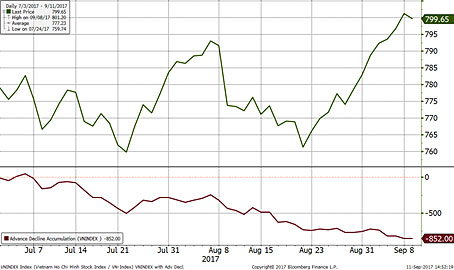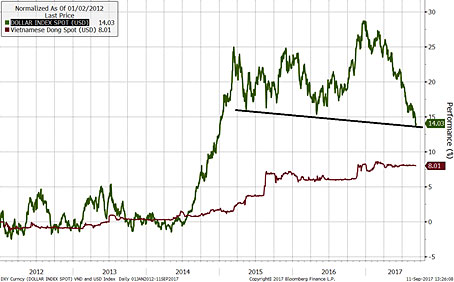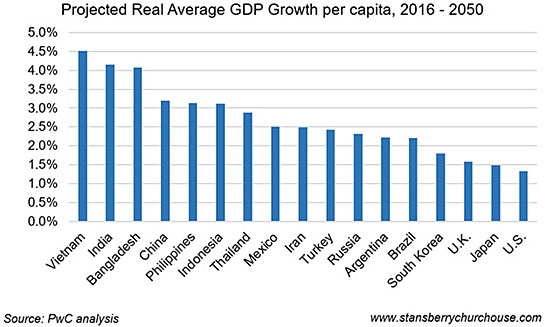The Vietnam Fund returned -4.4% in August with a NAV of USD 1,820.85, bringing the net return since inception to +82.1%. This represents an annualised return of +17.6% p.a. The August performance of the Ho Chi Minh City VN Index in USD was -0.2% while the Hanoi VH Index gained +2.6% (in USD terms). Since inception, the AFC Vietnam Fund has outperformed the VN and VH Indices by +39.2% and +40.8% respectively (in USD terms). The broad diversification of the fund’s portfolio resulted in a low annualized volatility of 9.20%, a high Sharpe ratio of 1.89, and a low correlation of the fund versus the MSCI World Index USD of 0.30, all based on monthly observations since inception.
Market developments
In August, we saw a broad correction early in the month. While blue chips, led by banks, recovered strongly and small- and mid-caps underperformed with their indices declining by about 3% in August, many of our stocks also corrected strongly over the month which provided us with a nice opportunity to reduce our cash position and to invest in the most attractively valued companies in our portfolio. We also decided to exit a small-cap position which we had since the beginning of the launch of our fund, at an attractive price level.
HCMC Index and Advance/Decline Ratio

(Source: Bloomberg)
As in previous years, during periods of extremely weak market breadth (advance / decline ratio), it is next to impossible to escape losses with a broadly diversified portfolio, as we are running. The real astonishing and disappointing development was the divergence of the majority of stocks and index heavyweights like for example Asia Commercial Bank, which rose by more than 10% in August, and which cannot be bought by foreigners since the foreign ownership limit has been reached for years. On the positive side, such sharp corrections without any negative economic news offer great bargain buying opportunities, and hence we used some of our cash to increase the position size in all of our most attractively valued stocks.
Meanwhile, the weakness in the USD has taken pressure off of any meaningful depreciation in the Vietnamese Dong, although seasonal weakness towards year end is quite likely. We rightly pointed out a top in the USD index in early 2017 and the following weakness in the greenback helped emerging market stock markets immensely this year. It now looks like the USD is oversold on a medium-term basis and is testing important support levels, and it therefore will be interesting to see where currencies are heading in the coming weeks.
USD Index versus Vietnamese Dong – 5 years

(Source: Bloomberg)
Whatever the future direction of the USD holds, the volatility in the USD is certainly much higher than in the Vietnamese Dong, which has moved less than 10% over the past 5 years. Other major currencies including the Euro and Japanese Yen have been even more volatile with fluctuations of between 30-40% over the past five years.
Although emerging markets performed well in 2017, they are still undervalued versus developed markets, which are trading at pre-crisis valuations and most indices are already higher than 10 years ago. Both frontier and emerging markets would have to rise about 50% to match those valuations, not to mention the current valuation of our portfolio, which would have to rise another 50%, just to catch up with the current valuation level of Vietnamese large caps.

Despite many uncertainties, one can clearly the optimism in the long term for Vietnam, which is also the reason why we launched the AFC Vietnam Fund a few years ago.
Economy
In August 2017, industrial production reached 8.4% compared to 7.3% in Aug 2016. Total industrial production in the first 8 months of 2017 grew at 6.7% YoY which shows an ongoing improvement in Vietnam’s economy.
FDI continues to be the most important topic in August. Total FDI disbursement reached USD 10.3 billion, increasing 5.1% YoY. Through 20 August 2017 pledged FDI reached USD 23.4 billion, expanding by 45.1% YoY.
Export values continued to grow impressively, by 17.9% in August, one of the fastest export growing countries in the world, to USD 133.5 billion. Value of imports was USD 135.6 billion, leading to a slightly smaller trade deficit of USD 2.1 billion in comparison to 1H2017.
The headline CPI in August increased to 3.35%, meanwhile the core CPI stood at 1.31%. The low CPI helps to stimulate domestic consumption. Furthermore, loose monetary policy and credit stimulation policy has significantly encouraged consumption. Total retail sales for the first eight months of 2017 grew 10.3% compared to 9.3% YoY.
At the end of August 2017, the fund’s largest positions were: Agriculture Bank Insurance JSC (3.4%) – an insurance company, Sam Cuong Material Electrical and Telecom Corp (2.5%) – a manufacturer of electrical and telecom equipment, Pharmedic Pharmaceutical Medical JSC (2.2%) – a pharmaceutical company, Cantho Pesticides JSC (2.0%) – a manufacturer of agricultural chemicals, and National Seed JSC (1.9%) – an exporter of seeds.
The portfolio was invested in 76 names and held 5.0% in cash. The sectors with the largest allocation of assets were consumer goods (34.1%) and industrials (26.5%). The fund’s estimated weighted average trailing P/E ratio was 9.67x, the estimated weighted average P/B ratio was 1.70x and the estimated portfolio dividend yield was 7.06%.
